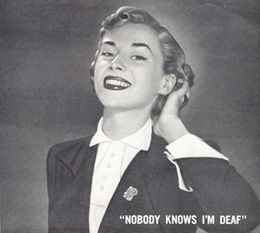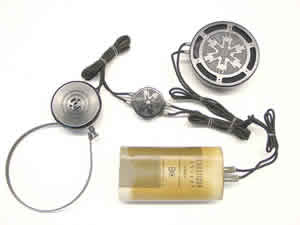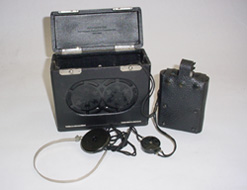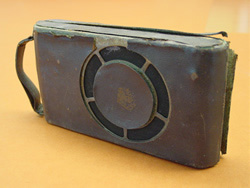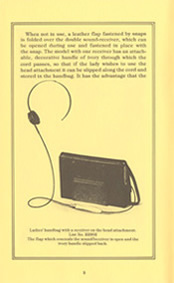Concealed Hearing Devices of the 20th Century
“Let it not be said of the hard of hearing, "Vanity, vanity,
all is vanity.”
— S. R. Silverman, Ph.D., 1947
During the 20th century, aids for hearing evolved from mechanical to electrical devices. Using an external power source, sounds could now be made louder than was possible with earlier mechanical designs. Consequently, hearing aids were able to provide amplification of sound to those even with severe to profound hearing loss. Coincident with the change from mechanical to electrical designs were advances in technology that paved the way for innovative designs of concealed hearing aids and allowed for manufacture of hearing aids at more affordable prices.
Early Electrical Hearing Aids were based on telephone technology invented by Alexander Graham Bell in the late 19th century. A carbon-granule microphone in combination with a battery could produce sound at an earphone at levels greater than those possible with mechanical devices. Carbon hearing aids, while effective for moderate losses, had limited amplification and poor-to-moderate sound fidelity.
| DeForest Universal Audiophone, 1938 | Acousticon Model 56, 1928 |
|---|---|
| Concealed designs were limited primarily to stationary items resembling tabletop appliances such as radios. | |
| French Electric “Camera” | |
|---|---|
| This aid, manufactured by the French Electric Co., around 1930, is housed in an interesting camera-style case. This is an unusual example of an electrical concealed hearing device. |
| Amplivox “Purse” | |
|---|---|
| One ingenious example of a carbon hearing aid designed for camouflage was the purse model by Amplivox created around 1935. The purse contained the battery pack and microphone and the user held the earpiece to her ear while holding the purse so the microphone faced the talker. | |
Courtesy of Amplivox/Ultratone Museum |
| Siemens Halske Wallet and Purse hearing aids, 1920s | ||
|---|---|---|
| The Siemens Halske Company, founded in 1847 to build telegraph lines, was located near Berlin, Germany. A medical department was organized in 1877, and in 1910 the company began manufacturing hearing devices. These illustrations of devices from a 1920s Siemens Halske catalog show a wallet hearing aid and aids concealed in ladies’ handbags. | ||
“In America the users of hearing devices seem to be more inclined to accept the electrically amplified instruments. It is also noticeable that comparatively few use any form of camouflaged trumpets . . . ”
— Max A. Goldstein, M.D., 1933

